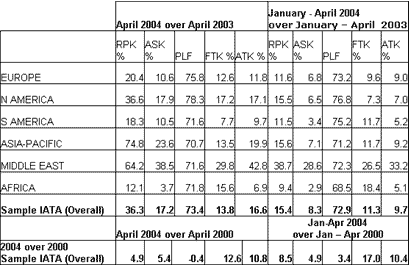GENEVA – "A year after the devastating impact of SARS and the War in Iraq, industry efforts to rebuild passenger confidence see traffic largely recovered. The problem is now on the cost side," said Giovanni Bisignani, Director General and CEO of the International Air Transport Association.
"On average, fuel accounts for 16% of airline operating costs. Fuel prices are 55% higher than one year ago. This could add between US$8 and US$12 billion to our annual fuel bill and threatens to strangle our modest projected return to profitability. Instead of flying high, we could be left swimming in red ink," said Bisignani.
IATA today announced that passenger traffic for the first four months of 2004 was up 15.4% over 2003 while freight traffic improved by 11.3% for the same period. More meaningfully, when compared to 2000 traffic levels for the same period, global passenger and cargo growth are 8.5% and 17.0% respectively.
"The current crisis resulting from sky high fuel prices once again highlights the industry's vulnerability to external shocks," said Bisignani. This will be front and centre when airlines meet at IATA's Annual General Meeting and World Air Transport Summit in Singapore, June 6-8. "We need to build a new industry structure capable of withstanding external shocks and delivering sustained profitability. Airline cost-cutting, restructuring, and re-engineering are not enough—we need to change the industry's structure," said Bisignani.

Notes for editors:
2. Explanation of measurements:
a. RPK: Revenue Passenger Kilometres measures actual passenger traffic
b. ASK: Available Seat Kilometres measures available passenger capacity
c. PLF: Passenger Load Factor is % of ASKs used.
d. FTK: Freight Tonne Kilometres measures actual freight traffic
e. ATK: Available Tonne Kilometres measures available total capacity (combined passenger and cargo)
3. IATA statistics cover international scheduled air traffic; domestic traffic is not included.
4. All figures are provisional and represent total reporting at time of publication plus estimates for missing data.
5. Due to uncertainties in the adoption of the new ICAO statistical definitions by reporting carriers, care should be taken when making year comparisons.
IATA (International Air Transport Association) represents over 270 airlines comprising 98% of international scheduled air traffic.